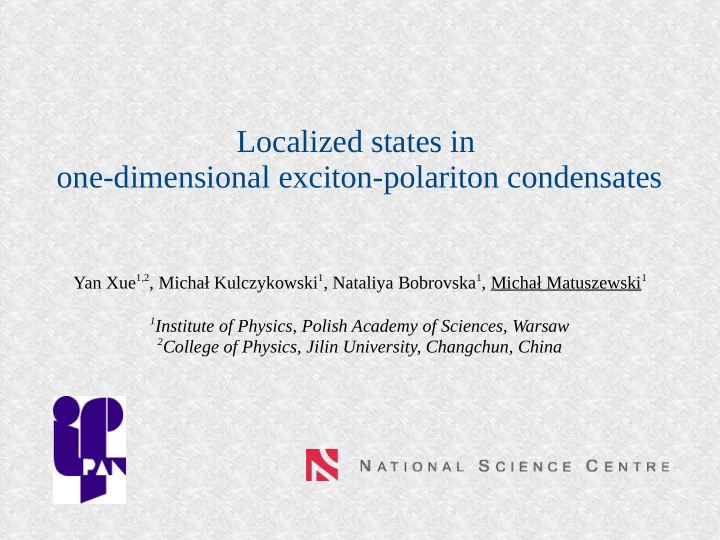

Localized states in one-dimensional exciton-polariton condensates Yan Xue 1,2 , Michał Kulczykowski 1 , Nataliya Bobrovska 1 , Michał Matuszewski 1 1 Institute of Physics, Polish Academy of Sciences, Warsaw 2 College of Physics, Jilin University, Changchun, China
Exciton-Polaritons polariton photon hole exciton electron ● Strong quantum coupling between excitons and photons ● Dressed states of exciton and photons are quasiparticles called polaritons
Exciton-Polaritons Semiconductor microcavity upper polariton lower polariton
Exciton-Polariton condensation (polariton lasing) Polaritons are bosons – BEC phase transition can be expected at standard cryogenic temperatures or even at room temperature due to a low effective mass (10 -5 electron mass) 2 / 3 T c ∼ n m
Exciton-Polariton condensation Above threshold pumping power, the ground state becomes massively occupied. The thermal cloud is found to be at 19K. (J. Kasprzak et al., Nature 2006)
Exciton-Polariton condensation in a 1D nanowire We consider a single isolated nanowire J. Bloch et al., Nat. Phys. (2010)
Exciton-Polariton condensation in a 1D nanowire Mean field approximation + description of the reservoir with a density field Pumping P(x,t) ⇓ n R (x,t) Exciton reservoir ⇓ Polariton ψ (x,t) condensate
Exciton-Polariton condensation in a 1D nanowire Mean field approximation + description of the reservoir with a density field Polariton condensate Exciton reservoir M. Wouters and I. Carusotto (2007)
2 ψ i ψ t =( a + ib ) 2 ψ+ ie ψ 2 +( c − id )|ψ| x
Sources
What is the difference between a dark soliton and a heteroclinic hole? Conservative Nonlinear Schrodinger Equation Dissipative Complex Ginzburg-Ladau Equation 2 ψ i ψ t =( a + ib ) 2 A = 0 2 ψ+ ie ψ 2 +( c − id )|ψ| iA t + A xx −∣ A ∣ x A dark soliton A heteroclinic hole (source) Bekki-Nozaki hole solution (N. Bekki and K. Nozaki, 1985) Tanh-shaped dark soliton solution ● Localized density dip ● Localized density dip ● Phase “jump” in the middle of the soliton ● Phase “jump” in the middle of the soliton ● Source of outgoing plane waves In the limit of vanishing dissipative terms the Bekki-Nozaki solution transforms into the dark soliton.
Holes in polariton condensates ● Lifetime of solutions is extremely long compared to all natural timescales ● Eventually, holes decay due to the acceleration instability ● The acceleration is related to the structural instability of CGLE against higher-order perturbations Y. Xue and M. Matuszewski, Phys. Rev. Lett. (2014)
Oscillations and explosions Close to the low power stability threshold, the solutions exhibit nontrivial dynamics. Such behaviour is absent in the case of standard complex Ginzburg-Landau equation. Bright exploding solitons: J. M. Soto-Crespo, N. Akhmediev and A. Ankiewicz, Phys. Rev. Lett. 85, 2937 (2000)
Bogoliubov-de Gennes analysis ● Both modes have small growth rates of the order of (1000 ps) -1 , which well explains the long period of time necessary to destabilize the solution ● When the perturbation grows sufficiently large to make the Bogoliubov linearization invalid, the instability speeds up, leading to abrupt decay of the hole ● The decay is related to the structural instability of CGLE against higher-order perturbations (O. Stiller, S. Popp, L. Kramer, Physica D 84, 424, 1995)
Spatially modulated pumping A flux of polaritons from areas of stronger pumping to areas of weaker pumping is naturally induced. The solitons are created spontaneously when the flux velocity becomes comparable to the sound velocity. Thus, here the mechanism of hole creation is through the breakdown of superfluidity.
Vortices in the two-dimensional case A vortex can be created from a small seed possessing a quantum of angular momentum. The solution remains stable for a very long evolution time. Y. Xue and M. Matuszewski, Phys. Rev. Lett. (2014)
Sinks
Interference vs. sink Linear Nonlinear Interference Sink Kulczykowski, Bobrovska, Matuszewski, arXiv:1501.07791, to appear in PRB
Sink movement Equal sources Unequal sources Kulczykowski, Bobrovska, Matuszewski, arXiv:1501.07791
Spontaneous holes in a nonequilibrium steady state
Result within the truncated Wigner approximation: holes appear spontaneously in the nonequilibrium steady state see also: dark solitons in atomic BECs in thermal equilibrium, T. Karpiuk et al., Phys. Rev. Lett. 109 205302 (2012)
Conclusions ● Mean-field equations of exciton-polariton condensates admit source (hole) and sink (shock) solutions that have corresponding solutions in the CGLE ● Polariton holes exhibit interesting dynamical properties that are more rich than those of the CGLE ● Holes (dark solitons) can appear spontaneously in a dynamical steady state Thank you for your attention!
Recommend
More recommend